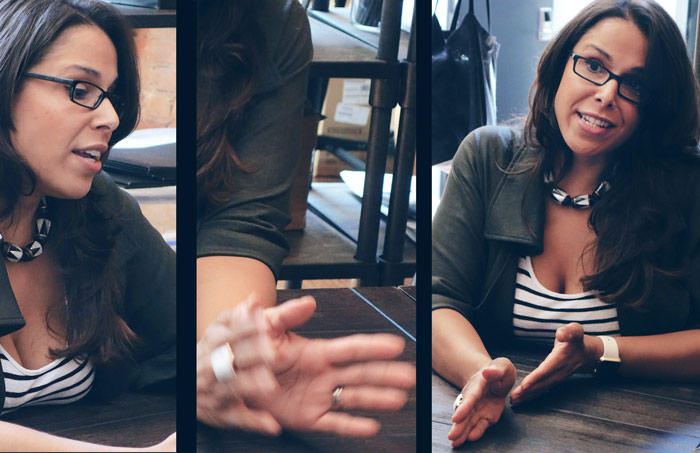Full Transparency
Our editorial transparency tool uses blockchain technology to permanently log all changes made to official releases after publication. However, this post is not an official release and therefore not tracked. Visit our learn more for more information.
The vision for this series is to surface and share insights of thought-leaders and trailblazers who live at the cutting edge of technology. While the opinions featured may not necessarily represent those of Verizon and its employees, we still believe that we can each learn from experiences and opinions of others, which is why we’ve chosen to feature them here. This dialogue is how we take the first steps towards making innovations that matter.
It was a bright and crisp Spring afternoon in NYC. NYers were wearing sunglasses, bold colors, and were smiling widely. Spring had arrived. On the top-floor loft space in NYC’s fashion district, where I was meeting with Lisa Morales-Hellebo, the sun streamed brightly through the skylight. It was a beautiful day.

Lisa Morales-Hellebo is a high-impact, razor smart tech founder who is working on a new business model for fashion. Her new company, Refashiond, uses tech to scale a highly personalized form of manufacturing. With Refashiond, tech isn’t replacing the skilled and creative people who design and produce the garments; it’s creating more opportunity through scaling the behind-the-scenes operations of creating fashion garments. Plus, her company is bringing garment production closer to home. By working with factories in Puerto Rico, garments can be produced and shipped quickly, providing the buyer with close to real-time delivery of their ready-to-wear quality garment.
We sat at a rough-hewn, dark wood table with steel framing and legs. We were talking about her vision for the future of tech. I launched into our conversation, asking for her reaction to “The future of mobile.” Lisa jumped in with a thoughtful and urgent trajectory. Each idea she shared built on the previous. As the ideas flowed from Lisa’s brain, she noticed I wasn’t always sure of the vernacular, and she was kind enough to slow down at times to explain. At the same time, her vibrancy wanted to carry her into light speed.
People are the brand-currency of the future
“Universal taxonomy?” I repeat the term back to Lisa, trying not to sound too naïve.
“Yeah,” she says, nodding graciously, enthused that I’m starting to catch up to her brilliance, “…as you're walking down the street you'll be able to hold up your phone and through augmented reality see everyone that is most similar to you, part of your style tribe and shares a similar style DNA. A universal taxonomy will be the standardized data that will enable this.”
“Style tribe?” I ask.
“Yeah, I came up with that when I built Shopsy, my contextual search engine for apparel shopping in 2010. So back then I was envisioning our style tribes and our style DNA all coming from our data of how we shop, a mixture of subjective and descriptive data around what we do and how we do it and why we do it. And that all comes from this 'meta' living in the ethos around commerce."
You know, she just happened to build a contextual search engine - plus, she invented new nomenclature, a new language to go with it. Lisa has launched communities, such as NY Fashion Tech Lab, as well as services, such as her new venture Refashiond. She refers to herself as a community catalyst. That’s an understatement.
The biggest opportunity for fashion tech is invisible
“A lot of the current focus within fashion tech is the ‘front end,’” Lisa continues, “where the customer interfaces with the brand. This represents a small fraction of the true opportunity. Fashion tech, in my definition, is all innovation that occurs at the intersection of fashion, retail and technology. So that's really massive.”
"Where are the investors focused?" I ask.
“Unfortunately what investors have currently been investing in merely represents the $250 billion of front-end ecommerce, consumer facing consumption of fashion. As opposed to the $1.7 trillion of global market-share for production, supply chain, sourcing, distribution, point of sale, merchandising, you know all of that unsexy stuff that everyone doesn't want to acknowledge, which actually creates the fashion industry and pushes those garments to market.”
“That's the stuff where there's the biggest opportunity for innovation. And that's where I see the excitement around what we're building, because we are redefining the supply chain.”
If your focus is on the back-end of fashion, are you being a disruptor in parallel to being an innovator?
“If you can look at all the latest stories in every major publication about China, sort of imploding because of their toxic work environments, their horrible wages, their child labor…India also, and then you see the titans of our industry shutting down hundreds of stores and laying off thousands of employees. It is an interesting evolutionary moment in the history of fashion.”
Depending on how you read the current crop of headlines about retail, they are either gloomy threats on the death of an industry or, as Lisa sees it, new and abundant opportunities for innovation. “Fashion tech is really going to be part of the rebirthing of this industry. Whoever comes in as a digital native has a the advantage. Digital natives are like Rent the Runway or Nasty Gal or Mod Cloth or Warby Parker. Any of these brands that were born in the digital era as opposed to all these digital immigrants that are your old school retailers that are now mired with their existing infrastructure that's so archaic, and they can't get out of their own way fast enough.”
Digital immigrants better get with it
Lisa is identifying new opportunities in the gaps between digital native businesses (businesses started with connectivity as a norm) versus digital immigrant businesses (businesses needing to pivot to become “digital”). This quote from the HuffPo clearly frames the context, “Where digital natives imagine a world with little institutional structure and open access to people of diverse backgrounds, the culture of digital immigrants is a meritocracy…digital immigrants are goal oriented as opposed to the value orientation of the digital natives.”
I ask Lisa what the future of retail look like as it shifts from merit towards open access. Lisa has a vision.
“I see that we have an opportunity via mobile, as we were discussing before. You hold up your phone and augmented reality displays icons floating over everyone's heads and identifies the ones that are part of your style tribe. And then you can ‘shop’ those people - meaning you can click on them on your phone and gain access - not just what they're wearing, but what's in their entire closet.”
“Whoa,” I say out loud without realizing I did. Lisa sees my eyes brighten and picks up her momentum.
“Yes, shop the stranger on the street. And that's going to be the new currency with brands because shopping isn't going to be about location, retail, brick and mortar, even online. It's going to be this peer to peer commerce that really is going to start to emerge once we get to a standardization of data.”
Standardization? Such as in personalization?
“I think you're going to have more technology that's on the offensive of creating your own boundaries, that automatically let or don't let certain data or bots in to scrape or gather, et cetera. So I think that's going to be a big shift in the privacy space.”

The coming personalization rift
Access to a global opportunity, such as commerce, will require a new way to think about privacy. Lisa discussed this future of balancing personalization and privacy, using her family as an example.
“My son is 11 years old. And he's online all the time. His primary method for learning is YouTube and Google. He has taught himself java and scratch from MIT. And he will eagerly follow a game developer online and then reach out to him to ask a question. My son should be able to tap into his “most used meta,” that would include Minecraft java mods he’s made, and then layering that meta data with his age, who he follows on YouTube, and all of these things could collectively inform a bot to give him gated access to certain types of content. His meta will feed into an algorithm, a bot. I think there is an opportunity for innovation in this space. There's going to be this need, because kids are getting online younger and younger.”
As she expressed this notion she could tell I was losing some enthusiasm. I asked, “What happens when people don’t want to share their meta?”
“There's going to be this more distinct bifurcation of markets, a rift of those who open their meta and those that don’t. Of course there's going to be some people in the middle, but there's going to be a need for totally new ways to serve each end of this spectrum. And both of ends are pretty exciting and will create whole new opportunities for how do you use meta and how do you communicate with someone that's now off the grid and intentionally so.”
I asked how this on and off the grid future relates to and impacts communities without the same levels of access to technology.
“Right,” as if she was predicting my question, “because all you need is that access to have a way out of your situation. And right now the more we remove that access from people the more we get these vast divides of not only haves and have nots but haves and haves not of ‘knowledge.’ And right now you're sitting there with the world in your pocket and all this information, and the have nots are really just fed whatever the news decides to tell them.”
Lisa is an iconoclast. I don’t use this term lightly. I never considered the idea of “shopping a person,” nor sharing my meta to teach my bot how to gather information for me. Lisa’s vision of the future is less ominous and more playful, less cumbersome and more light, more experiential and less time wasted time and effort.
I look up from our table and into the bright light of the skylight. The sky is clear and blue and endless, the perfect metaphor for a conversation with Lisa.
In part two of this interview we’ll expand on the idea of personal meta and algorithms. We’ll talk about bots and new pathways.
Read more conversations from this series:
- The Valley isn't interested
- The "co" in "coworking" is for community
- Making good things scale, globally
- Tech that breaks the cycle of poverty
- Showing the way into a tech life
- The future of health will be mobile
- The future is wondrously human
- Leadership success in our diverse and accelerated era
- For learning to scale, time needs to be fluid
- Re-envisioning the food supply
- There’s more to your beautiful plate of food than you realize
- Diversity in Tech - The tech population doesn’t reflect the true population
Jason Moriber is a creative communicator with a background in social and digital for CSR, tech and start-ups. He’s working within the Communications team at Verizon, charged with developing a new model for corporate and brand communications. Connect with him on Twitter @jasonmoriber or on Instagram @designinginnovation